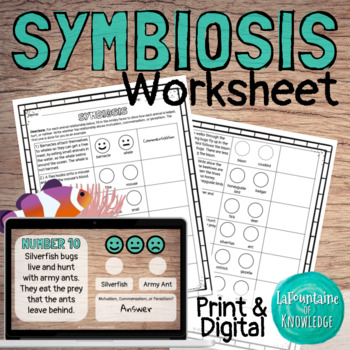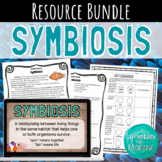Symbiosis Animal Relationships Worksheet PRINT and DIGITAL
- PDF
- Google Apps™

What educators are saying
Also included in
- This bundle of resources is perfect for teaching about symbiotic relationships between living things (both plants and animals). It includes:a Google Slides presentation (present in class or assign remotely via Google Classroom) with self-checking comprehension questionsa reading comprehension passagPrice $6.65Original Price $9.50Save $2.85
Description
This symbiosis worksheet includes 12 examples of symbiotic relationships between plants and animals. To complete, students will:
- read each symbiotic relationship scenario
- draw a smiley face, a straight mouth face, or a frowny face to show whether each animal benefits, is neither helped nor harmed, or is harmed by the relationship
- decide whether the relationship demonstrates mutualism, commensalism, or parasitism
This download also includes a digital, Google Slides version. Students drag and drop the smiley faces and type into text boxes to record the type of relationship. An answer key is included.
Please follow my store here for more great resources!
You can also find me on Facebook, Instagram, and lafountaineofknowledge.com where you'll discover ideas, inspiration, and plenty of freebies! Or join my email list to get my monthly newsletter with exclusive FREE resources you can't get anywhere else!
Want free money to spend on Teachers Pay Teachers? Rate this product to earn some TpT credit! Leaving feedback helps us both out and takes less than a minute! Your support makes it possible for me to continue making and sharing great resources! Thank you!
Credits: Clip art by Chirp Graphics, Mostafa Elturkey, and Acaladolopes , used with permission. Cover photograph sourced from Pixabay and used with permission. Fonts include: Londrina Solid and Londrina Sketch by Marcelo Magalhães, Gloria Hallelujah by Kimberly Geswein, and Pangolin by Kevin Burke. All fonts used with permission under open source licenses.






